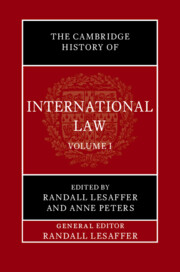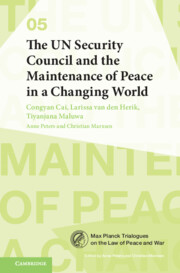572 results

The Cambridge History of International Law
- Coming soon
-
- Expected online publication date:
- November 2024
- Print publication:
- 31 October 2024
-
- Book
- Export citation
Social security and retirement around the world: lessons from a long-term collaboration
-
- Journal:
- Journal of Pension Economics & Finance , First View
- Published online by Cambridge University Press:
- 19 September 2024, pp. 1-23
-
- Article
-
- You have access
- Open access
- HTML
- Export citation
DivFolio: a Shiny application for portfolio divestment in green finance wealth management
-
- Journal:
- Annals of Actuarial Science , First View
- Published online by Cambridge University Press:
- 13 May 2024, pp. 1-44
-
- Article
-
- You have access
- Open access
- HTML
- Export citation
Implementation of the World Health Organization's QualityRights initiative in Ghana: an overview
-
- Journal:
- BJPsych Open / Volume 10 / Issue 3 / May 2024
- Published online by Cambridge University Press:
- 13 May 2024, e111
-
- Article
-
- You have access
- Open access
- HTML
- Export citation
Head and Neck Cancer: United Kingdom National Multidisciplinary Guidelines, Sixth Edition
-
- Journal:
- The Journal of Laryngology & Otology / Volume 138 / Issue S1 / April 2024
- Published online by Cambridge University Press:
- 14 March 2024, pp. S1-S224
- Print publication:
- April 2024
-
- Article
-
- You have access
- Open access
- HTML
- Export citation
Contents
-
- Book:
- The UN Security Council and the Maintenance of Peace in a Changing World
- Published online:
- 15 February 2024
- Print publication:
- 22 February 2024, pp vii-x
-
- Chapter
-
- You have access
- Open access
- HTML
- Export citation
Index
-
- Book:
- The UN Security Council and the Maintenance of Peace in a Changing World
- Published online:
- 15 February 2024
- Print publication:
- 22 February 2024, pp 299-310
-
- Chapter
-
- You have access
- Open access
- HTML
- Export citation
Copyright page
-
- Book:
- The UN Security Council and the Maintenance of Peace in a Changing World
- Published online:
- 15 February 2024
- Print publication:
- 22 February 2024, pp vi-vi
-
- Chapter
-
- You have access
- Open access
- HTML
- Export citation
Conclusion - Power, Procedures, and Periphery: The UN Security Council in the Ukraine War
-
-
- Book:
- The UN Security Council and the Maintenance of Peace in a Changing World
- Published online:
- 15 February 2024
- Print publication:
- 22 February 2024, pp 278-298
-
- Chapter
-
- You have access
- Open access
- HTML
- Export citation

The UN Security Council and the Maintenance of Peace in a Changing World
-
- Published online:
- 15 February 2024
- Print publication:
- 22 February 2024
-
- Book
-
- You have access
- Open access
- Export citation
The association between symptom burden and processing speed and executive functioning at 4 and 12 weeks following pediatric concussion
-
- Journal:
- Journal of the International Neuropsychological Society , First View
- Published online by Cambridge University Press:
- 26 January 2024, pp. 1-13
-
- Article
-
- You have access
- Open access
- HTML
- Export citation
Somatic multicomorbidity and disability in patients with psychiatric disorders in comparison to the general population: a quasi-epidemiological investigation in 54,826 subjects from 40 countries (COMET-G study)
-
- Journal:
- CNS Spectrums / Volume 29 / Issue 2 / April 2024
- Published online by Cambridge University Press:
- 25 January 2024, pp. 126-149
-
- Article
-
- You have access
- HTML
- Export citation
19 Auditory and Cognitive Function in Adults Living With and Without HIV
-
- Journal:
- Journal of the International Neuropsychological Society / Volume 29 / Issue s1 / November 2023
- Published online by Cambridge University Press:
- 21 December 2023, pp. 810-811
-
- Article
-
- You have access
- Export citation
10 - Literacy and Linguistic Diversity in Australia
- from Part I - Regional Variations
-
-
- Book:
- Global Variation in Literacy Development
- Published online:
- 23 November 2023
- Print publication:
- 07 December 2023, pp 203-238
-
- Chapter
- Export citation
Effects of in-store marketing on food and beverage purchases: a longitudinal study of households with children
-
- Journal:
- Public Health Nutrition / Volume 27 / Issue 1 / 2024
- Published online by Cambridge University Press:
- 01 December 2023, e4
-
- Article
-
- You have access
- Open access
- HTML
- Export citation
Changes in anxiety and depression during the COVID-19 pandemic in the European population: A meta-analysis of changes and associations with restriction policies
-
- Journal:
- European Psychiatry / Volume 66 / Issue 1 / 2023
- Published online by Cambridge University Press:
- 26 October 2023, e87
-
- Article
-
- You have access
- Open access
- HTML
- Export citation
Reciprocal relationships between stress and depressive symptoms: the essential role of the nucleus accumbens
-
- Journal:
- Psychological Medicine / Volume 54 / Issue 5 / April 2024
- Published online by Cambridge University Press:
- 26 September 2023, pp. 1045-1056
-
- Article
-
- You have access
- Open access
- HTML
- Export citation
Resilient functioning is associated with altered structural brain network topology in adolescents exposed to childhood adversity
-
- Journal:
- Development and Psychopathology / Volume 35 / Issue 5 / December 2023
- Published online by Cambridge University Press:
- 26 July 2023, pp. 2253-2263
-
- Article
-
- You have access
- Open access
- HTML
- Export citation
The cost-utility of a return-to-work intervention in comparison to routine care for patients with mental disorders in Germany: Results from the RETURN project
-
- Journal:
- European Psychiatry / Volume 66 / Issue 1 / 2023
- Published online by Cambridge University Press:
- 24 July 2023, e55
-
- Article
-
- You have access
- Open access
- HTML
- Export citation
Introduction
-
-
- Book:
- Armed Intervention and Consent
- Published online:
- 22 June 2023
- Print publication:
- 06 July 2023, pp 1-25
-
- Chapter
-
- You have access
- Open access
- HTML
- Export citation

